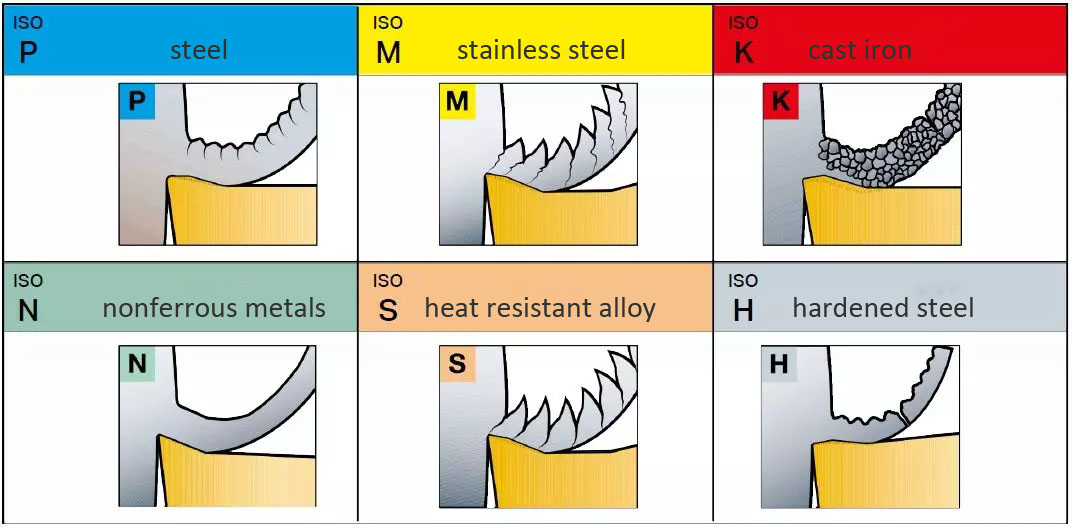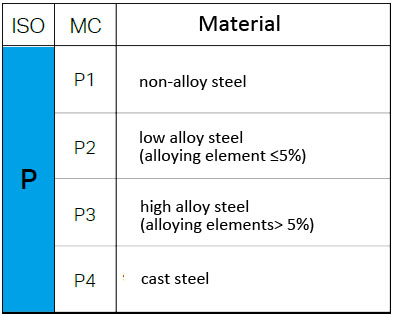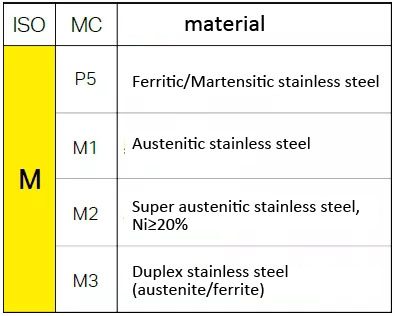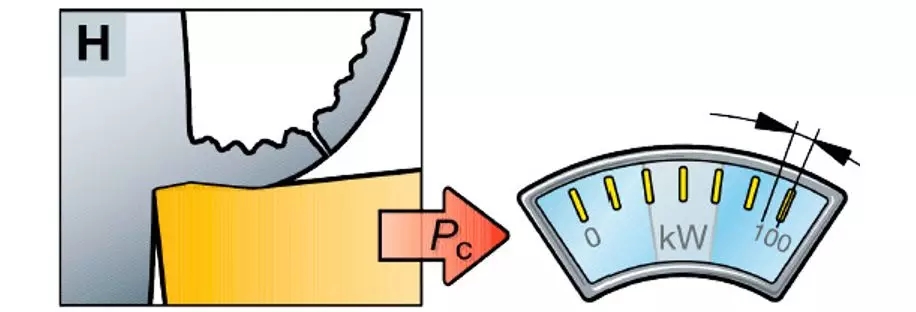In metal cutting, there will be different workpiece materials, and different materials have different cutting formation and removal characteristics. How do we grasp the characteristics of different materials? ISO standard metal materials are divided into 6 different types of groups, each of which has unique characteristics in terms of workability. This article will summarize them separately.
Metallic material is divided into six major categories:
- P- steel
- M- stainless steel
- K- cast iron
- N- nonferrous metals
- S- heat resistant alloy
- H-hardened steel

1-P Steel
What is steel?
-Steel is the largest material group in the field of metal cutting.
-The steel can be non-hardened steel or quenched and tempered steel (hardness up to 400HB).
-Steel is an alloy with iron (Fe) as the main component. It is manufactured through a smelting process.
-The carbon content of unalloyed steel is less than 0.8%, only Fe and no other alloying elements.
-The carbon content of alloy steel is less than 1.7%, and alloying elements such as Ni, Cr, Mo, V, W, etc. are added.

Application Areas:
In the range of metal cutting, group P is the largest material group because it covers several different industrial fields.
The material is usually a long chip material, which can form continuous and relatively uniform chips. The specific chip form usually depends on the carbon content.
– Low carbon content = tough, sticky material.
– High carbon content = brittle material.
Processing Characteristics:
-Long chip material.
-Chip control is relatively easy and stable.
-Mild steel is sticky and requires sharp cutting edges.
-Unit cutting force kc: 1500–3100 N/mm²
-The cutting force and power required to process ISO P materials are within a limited range.

2-M Stainless Steel
What is stainless steel?
-Stainless steel is an alloy material with a minimum of 11-12% chromium.
-Carbon content is usually very low (as low as 0.01% max).
-The alloys are mainly Ni (nickel), Mo (molybdenum) and Ti (titanium).
-A dense layer of Cr2O3 is formed on the steel surface to make it corrosion resistant.

Application Areas:
In the M group, most of the applications belong to the oil and gas, pipe fittings, flanges, processing industries and pharmaceutical industries.
Chip shape: The material forms irregular flaky chips, which has a higher cutting force compared with ordinary steel. There are many different types of stainless steel. The chip breaking performance (from easy to almost impossible to break) varies with alloy characteristics and heat treatment.
Processing Characteristics:
-Long chip material.
-Chip control is relatively smooth in ferrite, but difficult in austenite and duplex.
-Unit cutting force: 1800-2850 N/mm²
-High cutting force, built-up edge, heat and work hardening during machining.

3-K Cast Iron
What Is Cast Iron?
-There are three main types of cast iron: gray cast iron (GCI), nodular cast iron (NCI) and compacted graphite cast iron (CGI).
-Cast iron is mainly composed of Fe-C, with relatively high silicon content (1~3%).
-The carbon content exceeds 2%, which is the maximum solubility of C in the austenite phase.
-Cr (chromium), Mo (molybdenum) and V (vanadium) are added to form carbides, which increase strength and hardness, but reduce machinability.
Application Areas:
Group K is mainly used in auto parts, machine manufacturing and ironmaking.
Chip Shape:
The chip shape of the material is different, from powder-like chips to long chips. The power required to process this material group is usually small.
*Note: There is a big difference between gray cast iron (usually the chips are approximately powdery) and ductile cast iron. The chip breaking of the latter is often similar to steel.
Processing Characteristics:
-Short chip material.
-Good chip control under all working conditions.
-Unit cutting force: 790-1350 N/mm²
-Machining at higher speeds will cause abrasive wear.
-Medium cutting force.

4-N Non-ferrous Metals
What Is A Non-ferrous Metal Material?
-This category includes non-ferrous metals and soft metals with a hardness of less than 130 HB.
-Non-ferrous metal (Al) alloys containing nearly 22% silicon (Si) make up the largest part.
-Copper, bronze, brass.
Application areas:
Aircraft manufacturing and aluminum alloy automobile wheel manufacturers occupy a dominant position in Group N.
Although the power required per cubic inch is low, in order to obtain a high metal removal rate, it is still necessary to calculate the maximum power required.
Processing characteristics:
-Long chip material.
-If it is an alloy, chip control is relatively easy.
-Non-ferrous metals (Al) are sticky and require sharp cutting edges.
-Unit cutting force: 350-700 N/mm²
-The cutting force and power required to process ISO N materials are within a limited range.

5-S Heat Resistant Alloy
What Is A Heat-resistant Alloy?
-Heat-resistant alloys (HRSA) include many high-alloy iron, nickel, cobalt or titanium based materials.
-Group: iron-based, nickel-based, cobalt-based
-Working conditions: annealing, solution heat treatment, aging treatment, rolling, forging, casting.
-Features: Higher alloy content (cobalt is higher than nickel) can ensure better heat resistance, higher tensile strength and higher corrosion resistance.
Application Areas:
S group materials that are difficult to process are mainly used in aerospace, gas turbine and generator industries.
The range is wide, but high cutting forces are usually present.
Processing Characteristics:
-Long chip material.
-Difficult chip control (serrated chips).
-For ceramics, a negative rake angle is required, and for cemented carbide, a positive rake angle is required.
-Unit cutting force:
For heat-resistant alloys: 2400–3100 N/mm²
For titanium alloy: 1300-1400 N/mm²
-The cutting force and power required are high.

6-H Hardened Steel
What is hardened steel?
-From a processing point of view, hardened steel is the smallest group.
-This group contains quenched and tempered steels with hardness >45–65 HRC.
-Generally, the hardness of the hard parts being turned is generally between 55~68 HRC.
Application areas:
Hardened steels in Group H are used in various industries, such as the automotive industry and its subcontractors, as well as machine manufacturing and mold business.
Chip shape:
usually continuous, red-hot chip. This high temperature helps reduce the kc1 value and is important to help solve application problems.
Processing characteristics:
-Long chip material.
-Relatively good chip control.
-A negative rake angle is required.
-Unit cutting force: 2550-4870 N/mm²
-The cutting force and power required are high.



